

Author: Kent Moors, Ph.D.
A family spat has emerged between “mother” and me over what had been intended as the Spy Tale entry for today. There are several stories I want to tell that hit too many tripwires. Some of these involve our ongoing disagreement over what should still remain classified, others step on somebody else’s toes, and still others are blocked by ego, politics, or vested interest.
By the way, rest assured that intelligence agencies carry their own peculiar brands when it comes to these latter categories. Occasionally, in an attempt to protect an organization’s lineage, bona fides are kicked to the curb. Too many bodies remain buried in too many places, it seems.
Of course, “mother” is aware (since I have reminded the individuals involved in vetting) that there is no effective way to prevent my writing about such things anyway. However, for the moment at least, I would prefer not to go off reservation and still believe we can reach an accommodation. So, the discussion continues.
Good thing there are several already written and unused remaining on the approved list. So, this week, you are receiving one of them.
In an earlier edition of the Classified Intelligence Brief Spy Tale series, I made mention of some places I had spent Christmas during my intel years (“Remembering ‘Jake the Snake’ in Paris,” Classified Intelligence Brief, #45, December 23, 2020). As I noted then, a particularly dreary one spent in Hamburg often comes to mind.
This one occurred over a three-day period surrounding the holiday and played out in northern Germany. Actually, at the time it was more properly to be referred to as the Federal Republic of Germany (FRG), or West Germany as it was popularly known. Hamburg was close by the demarcation with the Soviet-dominated (and quite tongue-in-cheek named) German Democratic Republic (GDR, East Germany).
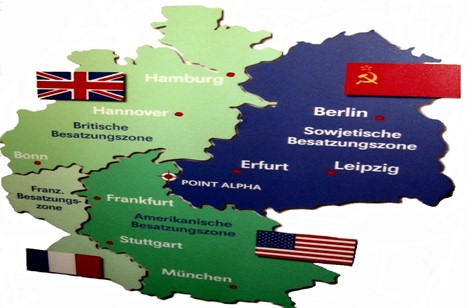

Located on the Elbe River connecting to the North Sea, the city had been a pivotal port ever since designation as a free imperial city in the Holy Roman Empire and a mainstay of the influential Hanseatic League of trading cities.
Hamburg was heavily bombed toward the end of World War II with about 35 percent of its population leaving before the war ended. Once the hostilities were over, the city ended up in the British Zone of Occupation, although the loss of outlying areas to the GDR in the post-war division significantly lowered its trading status.
The allied occupation of West Germany officially provided for in the Besatzungsstatut, or “Occupation Statute of Germany” drawn up by the American, British, and French, essentially ended in 1949 with the passage of the FRG constitution combining the three zones, although an Allied High Command and troops would remain throughout the Cold War.
Hamburg today is a vibrant city with a rebuilt skyline, robust cultural life, and high-rent harbor condos. But forty-five years ago (three decades after the war) it was slowly recovering with remnants of allied bombing raids still in evidence, especially in rundown areas by the port.
And that is where this tale unfolds.
I had just set up my first base in London – at the British Museum on a post-doctoral fellowship, shortly to move on to a regular appointment as a foreign lecturer at the London School of Economics and Political Science (LSE). The other part of my life involved phasing in responsibilities for US intelligence.
As I have noted on a number of previous occasions, most of that second career was in counterintelligence (CI) – watching the other guys, responding to KGB initiatives, and developing our responses. Basic to the undertaking was what happened on both sides of the division in Germany. Now, much of that centered about Berlin, the most spied upon city in the world and in most senses the frontline of the Cold War.
Berlin was completely encircled by the GDR. The city had itself been divided among the four powers after World War II, with the three western zones of the city later becoming absorbed into the FRG. That meant a part of West Germany was located 110 miles inside East Germany.
Moving in and out of Berlin could be harrowing. While there were several designated road thoroughfares, the primary and most heavily travelled crossing into East Germany was at Marienborn on the Hannover–Berlin autobahn. Beginning in 1971, the GDR expanded it into a large and imposing complex; the FRG (with US, UK, and French assistance) then built an equivalent checkpoint across a small strip of no man’s land at Helmstedt. Americans called this Checkpoint Alpha.
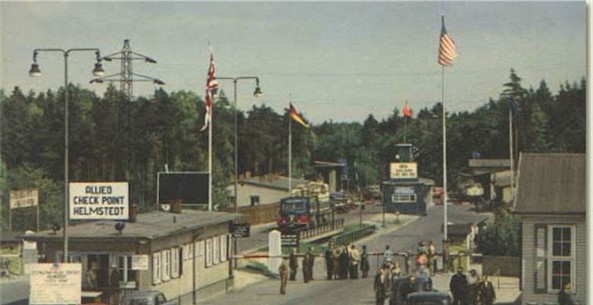

This was one of three the US (along with West Germany and allies) manned on the autobahn going to Berlin. The second, Checkpoint Bravo, was located at the border between the GDR and West Berlin, while clearly the most famous – Checkpoint Charlie –was the only place non-Germans could cross by road or foot from West to East Berlin.
All three would be the focal point of increasing tensions as armies confronted each other late in 1961.
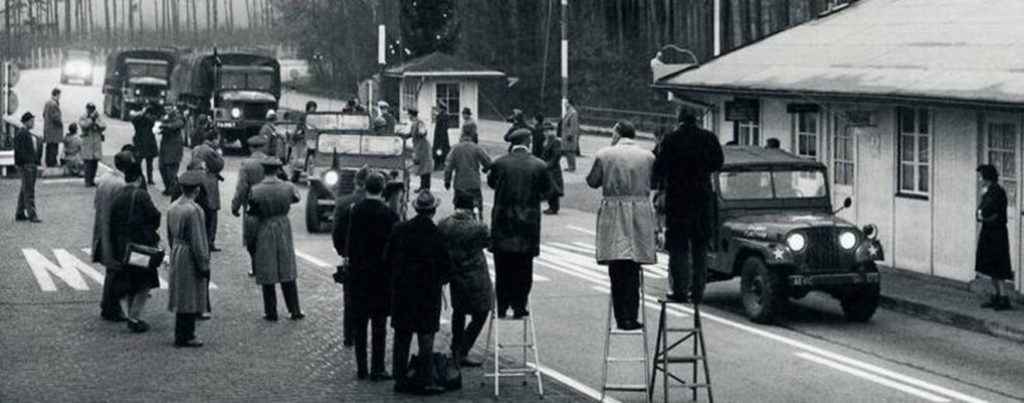

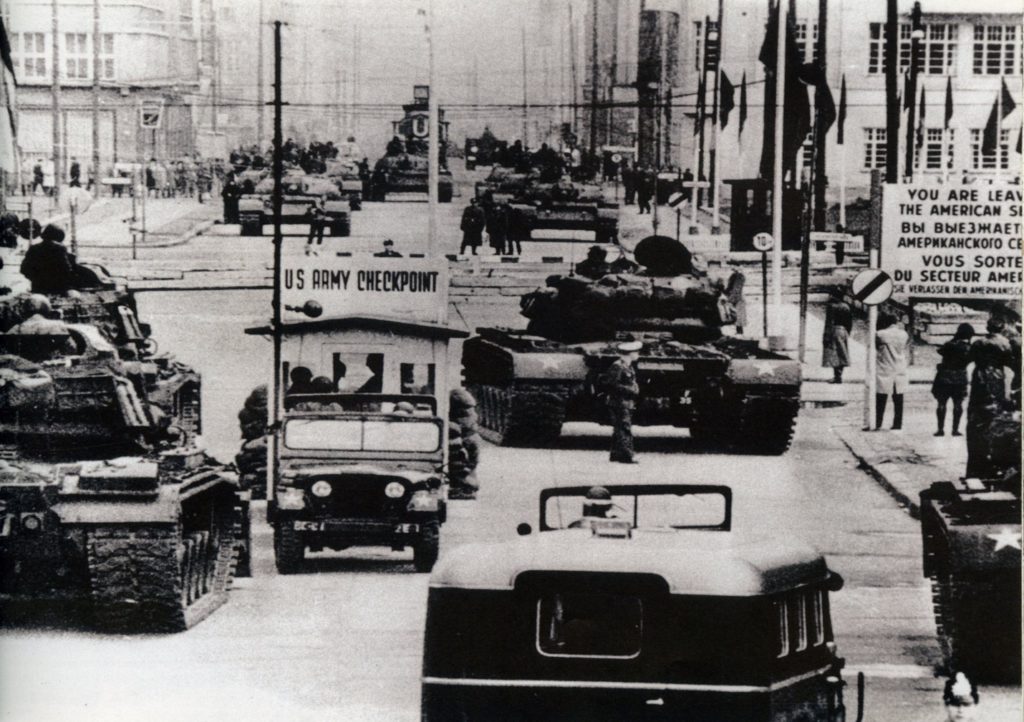

If you took the autobahn route, the GDR (and its Soviet socialist friends) would time you. If it was taking too long, they would send a patrol out looking for you. If you were reaching the East German border crossing just west of Checkpoint Bravo too early, they would issue a speeding ticket before leaving GDR territory.
So, the only times I went into Berlin I did so by air. That meant using Tempelhof, the airport in the old American sector. This was a harrowing experience as you flew directly into an urban area with little margin for error using runways not always in the best of repair.
This was the site of the famous Berlin airlift. Between June 24, 1948 and May 12, 1949, the US directed round-the-clock supply of West Berlin after the Soviets closed all road and river access in an attempt to force allied troops out.
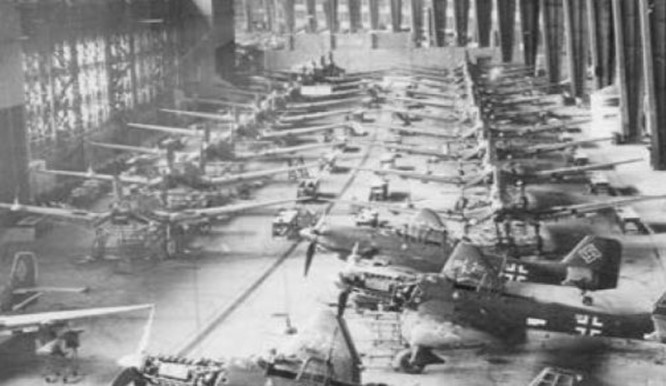

photo: thegermantimes.com
The attempted siege failed and the FRG was the result (with West Berlin becoming a part of a foreign country inside East Germany). Until the Wall came down and Germany was reunified, this arrangement was always a tinderbox awaiting a spark.
Throughout its post-WWII life, Tempelhof had suffered from Nazi ideas of architecture – huge buildings (like the hanger picture above) and short runways. Those runways were extended on several occasions by the Americans (since the airport was a responsibility of the US occupational administration), but by the time Tempelhof closed in October 2008 your heart was in your throat each time landing. Ten years after it was closed, the former airport became a refugee camp for the waves of immigrants coming into Germany.
Berlin may have been the apex of the spy game, but it was difficult to run significant operational networks from West to East Berlin given the marked ability of the Stasi (GDR state security) to infiltrate all manner of West German offices in the city. All of this was done under the legendary direction of Stasi head of foreign intelligence Colonel General Markus Wolf, whose success I described last year (see “An Unexpected Defection in Rio,” Classified Intelligence Brief, #39, December 2, 2020). Known as “the man without a face,” Wolf was hands down the most prolific plyer of spy craft throughout the Cold War.
Berlin remained the single most important espionage bastion. However, locations elsewhere in the FRG close to the GDR border were more successful bases from which to launch operational networks of assets in East Germany. Hamburg was high on this list.
The GDR and the Soviets needed to maintain an ongoing connection between German-Baltic Sea and German-North Sea maritime trade. The GDR had acquired the Baltic side (much at the expense of Hamburg) after the post-WWII demarcation, but had inferior harbor facilities. The FRG, on the other hand, had both the port of Hamburg and the Elbe River with its direct access to the North Sea. This made it necessary for the two Germanys uneasily to coordinate trade using Hamburg as the center.
That, in turn, provided us with opportunities to debrief and instruct East Germans in our asset/agent networks using cover from among the many GDR citizens coming in an out of Hamburg on “trade missions.”
Setting the stage for why on a cold Christmas Eve I was in a bleak part of the city. The Niedeerbaumbrüke section of the old port is today a nice combination of up-scale apartments, promenades, and trendy eateries.
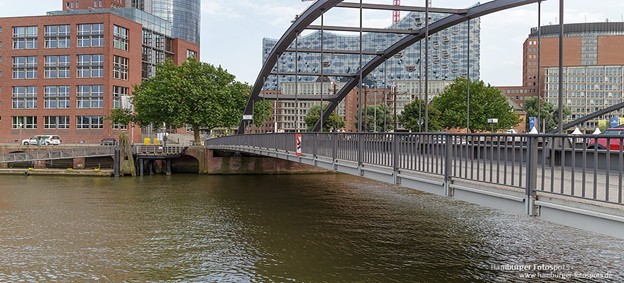

But 45 years ago, this was dotted with (to be generous) one-star transient hotels, a red light district, infrequently employed longshoremen, endless bars, and frequent fist fights.
A now long-departed run-down hotel was our base. There were some debriefings to finish and one rather important operational handoff involving an established agent (an East German spying for us and occupying an administrative position in the GDR trade ministry).
The handoff was from one case officer (returning to the States) to a newly arriving equivalent who would become the agent’s contact. Swapping the individual to whom an asset reports can be a tricky matter. The agent and case officer develop a personal connection and that is not always easily transferred to somebody new.
I was not either the outgoing or incoming officer. My responsibility in all of this was CI, something for which I did have some experience: provide physical “sweep” support against counterparty surveillance, securing areas prior to a meeting, running parallel routes to determine if either party to the handoff was under active surveillance, and setting up countermeasures if they were.
We were on friendly territory (West Germany). But the BND (the FRG intelligence agency) still took a dim view of allies playing games on their home court. Intel would be exchanged at some level (almost always well above my pay grade), but it would also be vetted. General Wolf had placed too many of his own eyes and ears within the West German apparatus. Any blowback could easily cost the lives of our agents. What was shared with our German allies, therefore, was carefully sifted.
That meant I would spend all of Christmas Eve and most of Christmas shadowing the agent before and after his meetings, looking for operatives from the other side. I was not privy to the meetings themselves. They were simply not my responsibility.
Well, it seems our friend decided to sample the nightlife that Niedeerbaumbrüke offered, replete with streetwalkers and bars. Made my job more difficult and exhausting. Saw parts of the city I have no interest in ever seeing again, drank too much coffee, and ducked too many “social invitations.”
In any event, he made the meetings and the handoff apparently went well. I made it back to my fleabag of a room and even managed calling the daughters to wish them a somewhat belated Merry Christmas.
Unfortunately, one of the girls asked, “Where did you go for Christmas, daddy? Did you meet anybody interesting?” I had to finesse an answer. No need in moving her into therapy too early.


Dr. Kent Moors
This is an installment of Classified Intelligence Brief, your guide to what’s really happening behind the headlines… and how to profit from it. Dr. Kent Moors served the United States for 30 years as one of the most highly decorated intelligence operatives alive today (including THREE Presidential commendations).
After moving through the inner circles of royalty, oligarchs, billionaires, and the uber-rich, he discovered some of the most important secrets regarding finance, geo-politics, and business. As a result, he built one of the most impressive rolodexes in the world. His insights and network of contacts took him from a Vietnam veteran to becoming one of the globe’s most sought after consultants, with clients including six of the largest energy companies and the United States government.
Now, Dr. Moors is sharing his proprietary research every week… knowledge filtered through his decades as an internationally recognized professor and scholar, intelligence operative, business consultant, investor, and geo-political “troubleshooter.” This publication is designed to give you an insider’s view of what is really happening on the geo-political stage.
You can sign up for FREE to Classified Intelligence Brief and begin receiving insights from Dr. Moors and his team immediately.
Just click here – https://classifiedintelligencebrief.com/






